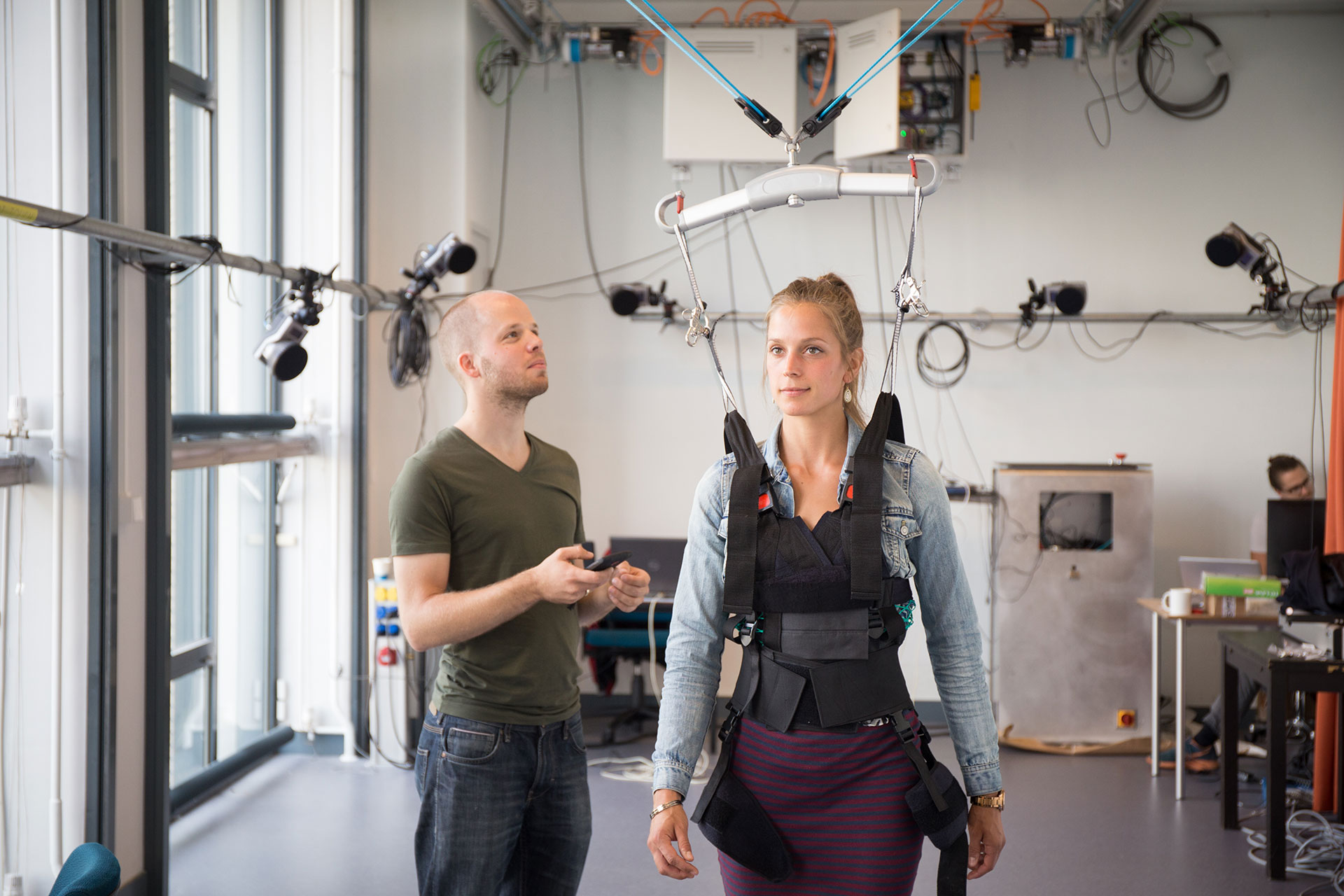Many people who suffer and survive strokes can’t walk unassisted independently again. Delft researchers developed a robot to help them rehabilitate.
Weight, height, age; once the computer has ingested all my personal parameters, it is time to put on the harness. I’m in a laboratory at the human motor augmentation section at the Faculty of 3mE. Robotics system engineer Michiel Plooij is tightening the straps of a harness around me. It is attached to a robotic trolley running along a 10 metre long track on the ceiling. I am about to go for a stroll. The safest ever. A virtual safety net created by the robot will prevent me from falling.
“You should have seen the smile on the face of the first stroke patient that tested this system,” says Plooij’s colleague Bram Sterke, who joined us in the laboratory. “Since his stroke he has had to use a walker for locomotion. Initially, it was hard for him to let go of it. But then he got the hang of our system and started prancing around without his walker! At one point he took a misstep and had to correct himself. That went well too. He wouldn’t have fallen anyway as the robot would have caught him at the last moment.”
Losing their balance
Robotic solutions to facilitate gait training in stroke patients have been studied for decades. Clinical evidence suggests that neurological recovery needs the active participation of the patient, including the errors that patients make such as losing their balance. This is exactly what this robot, to which I am strapped, allows. The robot, called the RYSEN, was invented by a group of Swiss and Dutch researchers, including Delft researcher Heike Vallery, professor of human motor augmentation. The system has recently been certified. An impressive feat, given the fact that the development of the prototype only started three years ago.
Like a stroll on the moon
The straps are tight and uncomfortable. But the walk itself feels like a stroll on the moon. The robot carries 60% of my weight. “Correction, it is like walking on Mars,” says Plooij. “On the red planet, the gravity is only about 40% of that on earth. On the moon, it is much less. We have to be careful, we don’t want to sell nonsense.”
Now that the robot has been certified, patients that want to use the device need to go to the academic hospital of the University of Lausanne which bought the first commercial robot. It was manufactured by the Dutch company Motek Medical. Plooij, until recently a postdoc in Vallery’s group, now works for this company. As does Bram Sterke. “We sold four more robots,” says Sterke. “None yet in the Netherlands. But we are hopeful this will happen soon.”
‘Suddenly I am gently being pulled backwards’
But what is so special about RYSEN? Robotic ceiling systems for rehabilitation were already developed some years ago. “Normally, in these systems, the same motors that provide the large unloading forces vertically also need to provide the high speeds horizontally to enable gait,” Vallery explains. “This means that they require extensive safety precautions and very strong electrical installations.” Vallery and her colleagues invented a double-sided variable-radius winch that allows the motors to be decoupled: slow/high torque motors for vertical motion and fast/low torque motors for horizontal motion.
Results from the clinical test
It is too early to say how effective the rehabilitation process is with this device. “We have to wait for the first results from the clinical test in Switzerland,” says Vallery. “But we already see that the device enables challenging and intensive training sessions. Our system allows people to train freely instead of being restricted by a treadmill. Not only can patients move forwards and backwards, but they can also walk sideways and practice walking up and down stairs. And the force can be adjusted so the system is not only able to catch people when they fall, but can also support or resist the motion, thereby enhancing the options for therapists in providing rehabilitation therapy.”
Smartphone
Using an app on his smartphone, Plooij gives instructions to the robot to illustrate what Vallery just said. Suddenly I am gently being pulled backwards. And then forwards, and backwards again. The stroll on Mars is a lot less comfortable now. It is time to release the straps. “Welcome back to earth,” says Plooij.
The RYSEN was developed by Motek Medical B.V., Delft University of Technology, GTX Medical and École Polytechnique Fédérale de Lausanne.



Comments are closed.